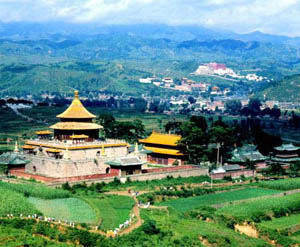 As the summer capital of the Qing (1644-1911)emperors, the picturesque Mountain Resort of Chengde (Bishu Shanzhuang) is awash in history and scenic beauty.
As the summer capital of the Qing (1644-1911)emperors, the picturesque Mountain Resort of Chengde (Bishu Shanzhuang) is awash in history and scenic beauty.
Its construction and the most flourishing times coincided with the most prosperous periods of Qing Dynasty (1644-1911). Five emperors of the early Qing Dynasty periods spent half the year at this Mountain Resort, giving it the name "court outside the Forbidden City" and making it an eyewitness to many historic events, including the death of two emperors and the signing of the infamy "Peking Treaty" with Britain, France and Russia in 1860.
The Mountain Resort with the 12 temples at its periphery and the nearby Mulan Hunting Ground to the north were listed as the World Cultural Heritages in 1994 by UNESCO.
When Kangxi, Qing's second emperor (1654-1722), commissioned the construction of the Mountain Resort at Chengde in 1703, he not only wanted a cool and refreshing summer retreat from the scotching heat in Beijing's Forbidden City, but also a massive hunting ground for game sports and contests of martial feats.
The emperor initiated the tradition of convening all the princes, generals and officials with their soldiers every autumn to the Mulan Hunting Ground, for a 20-day hunting sports which were actually contests of martial feats and cavalry.
The five Qing emperors - Kangxi, Qianlong, Jiaqing, Daoguang and Xianfeng - who would spend half the year there dealt with affairs of state as they enjoyed the moderate climate and hunting.
Kangxi also used the location to foster relations with northern nomad tribes. He, later continued by his grandson, Qianlong (1711-1799), built 12 temples at the periphery of the Mountain Resort in honor of the religious leaders of Mongolia, Tibet and Uygur.
Covering 5.64 million square meters, the Mountain Resort took 87 years to complete.
The resort is a microcosm of China's geography, with mountains in the west, plains in the north and lakes and creeks in the southeast. Famous sights from throughout the country are replicated here: Jiaxing's Yan Yu (misty rain) Tower, Ningbo's Tianyi Pavilion, Zhenjiang's Jinshan Temple and Suzhou's Lion Grove.
Lush green mountains, tranquil lakes and classic pavilions create a picture-postcard landscape. The club-shaped Bang Chui Shan Hill is visible from almost any vantage point throughout the resort compound.
The emperor's bed chamber and reading room is in Yan Bo Zhi Shuang (refreshing mist and waves) Hall.
On the bed draped with royal yellow silk bedspread, died two Qing emperors, Jiaqing and Xianfeng.
Emperor Daoguang, son of Jiaqing, closed the resort for almost 40 years, fearing a fate similar to his father's. But his son Emperor Xianfeng enjoyed the resort until the summer of 1860 when the Western powers' invading troops forced him to flee the Forbidden City to the resort and died there.
It was there that Xianfeng's 27-year-old widow, Cixi, later known as Dowager Empress, won in the court politics.
A small exhibition displays the empress' belongings there.
Of the 12 temples, eight used to house Tibetan lamas. Today, only Pu Ning Temple is home to 70 lamas, including many teen-age novices.
Draped in maroon robes, left shoulders exposed, the monks spin copper prayer wheels carved with Buddhist script. A stream of pilgrims pays homage, the more devout prostrating themselves with each step and weeping.
The temple boasts the one of the world's tallest wooden sculptures - a 27-meter-high depiction of Avalokitesvara (the God of Mercy).
To celebrate his 60th - and his mother's 80th - birthdays in 1770, Qianlong built a replica of Lhasa's Potala Palace in honor of the religious leaders from Mongolia, Tibet and Qinghai.
Perched on the Lion Mountain, the temple, with its red-and-white walls, is smaller than Potala.
Its Wan Fa Gui Yi (Every Religion Belongs to Royalty) Hall is magnificent. Fashioned from copper and gold, the grand roof blazes in the sunlight.
It was there that Qianlong hosted a grand reception for the sixth Tibet Panchen Lama, who, in return of this honor, traveled for an entire year in celebration of Qianlong's 60th birthday.
How to get there: Beijing is one and a half hours away by air, or 4 hours by train. Shanghai is 14 hours away by train (T14, departing at 6 p.m.).
Admission: 50 yuan for Mountain Resort of Chengde, 25 yuan for Pu Le Temple, 25 yuan for Pu Tuo Zong Cheng Temple
(China.org.cn)
|

